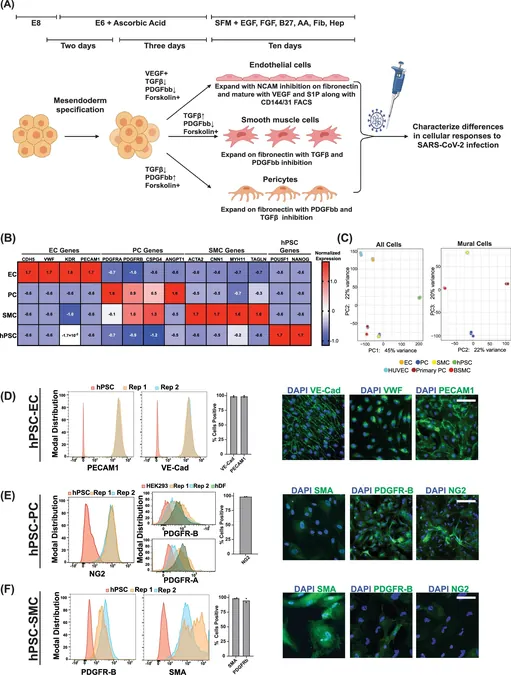
Unraveling the Mystery: How COVID-19 Affects Vascular Health and What It Means for the Future
2025-01-02
Author: John Tan
Introduction
The COVID-19 pandemic has fundamentally changed our understanding of respiratory diseases, highlighting its surprising impact on vascular health. While SARS-CoV-2 is primarily known for causing respiratory issues, a significant number of patients have reported severe vascular complications, leading to incidents such as blood clots, heart attacks, and strokes.
Groundbreaking Research
In a groundbreaking study, researchers from the Whitehead Institute, including founding member Rudolf Jaenisch, have shed light on these unusual effects. They utilized pluripotent stem cells to create crucial vascular and perivascular cell types—cells that surround blood vessels and maintain their function. This innovative approach allowed them to observe the behavior of these cells in response to SARS-CoV-2 more effectively than traditional methods.
The findings revealed that SARS-CoV-2 predominantly infects perivascular cells, and these infected cells send out distress signals, causing dysfunction in nearby vascular cells—regardless of whether those vascular cells are infected themselves. This discovery underscores the importance of cell-to-cell communication during viral infections, a factor often overlooked in virology research.
Innovative Cellular Models: A New Perspective on Viral Interactions
During the pandemic, researchers like Alexsia Richards, a virologist, and Andrew Khalil, a bioengineer, recognized a unique opportunity to collaborate. They aimed to understand the mechanisms through which SARS-CoV-2 affects vascular cells, leading to complications. By generating endothelial cells, smooth muscle cells, and pericytes within the same growth medium, they achieved a more accurate representation of how these cells interact and respond to viral infections.
Richards emphasized the need to observe how these diverse cell types influence one another during infections. Their approach allows for a higher resolution analysis of the virus's impact, paving the way for stronger hypotheses regarding vascular complications associated with COVID-19.
The Chain Reaction of Viral Infection
In experiments exposing these cell types to SARS-CoV-2, researchers witnessed that while smooth muscle and pericyte cells succumbed to infection, endothelial cells largely resisted. However, the proximity to infected smooth muscle cells resulted in significant inflammatory responses within the endothelial cells. This interaction led to weakening in the connections between endothelial cells—opening a potential pathway for blood leakage and further complications, which aligns with patient observations in severe COVID-19 cases.
The team's work indicates that the infection of smooth muscle cells is pivotal in initiating the cascade of vascular damage triggered by the virus. This finding emphasizes the importance of cellular interactions that occur within the human body, beyond a singular focus on isolated cell types.
Implications for Future Therapies
Crucially, the research findings have real-world relevance. The alterations in gene expression observed in the stem cell-derived model were consistent with markers found in COVID-19 patients who experienced vascular complications. Furthermore, a later variant of the virus, known as Omicron, was shown to have significantly less impact on vascular cells, mirroring clinical observations that suggest reduced vascular issues associated with newer strains.
The research team also investigated potential therapeutics, discovering that the drug N, N-Dimethyl-D-erythro-sphingosine could mitigate infection in smooth muscle cells without harming other vascular cell types. Although the urgency around COVID-19 vascular complications may be waning with the arrival of milder strains, the implications of this research stretch far into the future.
As new coronaviruses and pathogens are likely to emerge, the developed stem cell model presents an invaluable resource for rapidly screening and identifying effective treatments to combat future viral threats and their vascular ramifications.
Conclusion
"This interdisciplinary model not only enhances our understanding of SARS-CoV-2 but also holds promise for future research into viral pathogenesis," said Jaenisch, emphasizing the broader applications of their findings for ongoing and future health crises. With the global health landscape evolving, this research could be instrumental in addressing vascular complications associated with emerging viruses, helping scientists and medical professionals stay one step ahead.
 Brasil (PT)
Brasil (PT)
 Canada (EN)
Canada (EN)
 Chile (ES)
Chile (ES)
 Česko (CS)
Česko (CS)
 대한민국 (KO)
대한민국 (KO)
 España (ES)
España (ES)
 France (FR)
France (FR)
 Hong Kong (EN)
Hong Kong (EN)
 Italia (IT)
Italia (IT)
 日本 (JA)
日本 (JA)
 Magyarország (HU)
Magyarország (HU)
 Norge (NO)
Norge (NO)
 Polska (PL)
Polska (PL)
 Schweiz (DE)
Schweiz (DE)
 Singapore (EN)
Singapore (EN)
 Sverige (SV)
Sverige (SV)
 Suomi (FI)
Suomi (FI)
 Türkiye (TR)
Türkiye (TR)
 الإمارات العربية المتحدة (AR)
الإمارات العربية المتحدة (AR)